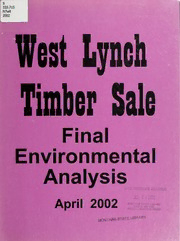
Environmental analysis for the West Lynch timber sale PDF
Preview Environmental analysis for the West Lynch timber sale
s 333.715 N7wlt 2002 West Lynch Timber Sale Final Environmental Analysis 2002 April -ARY J520 j,CWTM^»TAT£;i.iSsS^t-cf'iKJ.'/ MONTANASTATELIBRARY llinT|i|||nmnP111|flTii 3 0864 1001 5340 5 ENVIRONMENTAL ANALYSIS FOR THE WESTLYNCH TIMBER SALE BY PREPARED James ManagementForester KIbler, Montana DepartmentofNaturalResources and Conservation Northwestern Lands Office, KaIIspell/Plains Unit 2002 April Table of Contents page Environmental Assessment 1 Attachment Area Maps 1: Map Vicinity 5 Proposed Units and Transportation Plan Map 6 Attachment 2: Resources Analysis Vegetation Analysis 7 West Lynch Stand Map 13 Watershed, Hydrology and Fisheries Analysis 14 Wildlife Analysis 19 Attachment 3: Prescriptions 28 Timber Sale Unit Silvicultural Prescriptions Attachment 4: Project Plan Memo Objectives 44 Project Objectives and Specifications 45 West Lynch Timber Sale Existing Roads Map 47 West Lynch Timber Sale Project Roads Map 48 West Lynch Timber Sale Post Harvest Roads Map 49 Attachment 5: Mitigation 50 Attachment 6: Consultants and References 51 DS-252 CHECKLIST ENVIRONMENTAL ASSESSMENT Project Name: West Lynch Creek Timber Sale Proposed Implementation Date: June 2002 Proponent: Department Of Natural Resourees and Conservation, Northwestern Lands Office. Kalispell/Plains Unit. Type and Purpose of Action: The Department of Natural Resources and Conservation Proposes to sell 2L396 tons of timber in the Lynch Creek Drainage. This action would produce revenue for the Public Building (P. B.) Trust Grant. Activities proposed would maintain and improve forest health, reduce fuel loadings, and increase forest productivity beneficial to future Trust actions. No reasonable alternatives were identified or proposed dunng project scoping, therefore only forest product removal and sale are analyzed in this EA checklist. This proposal contains two alternatives for consideration: an Action and a No Action alternative. The Action Alternative proposes eight harvest units totaling 687 acres. An estimated 2L396 tons of timber would be harvested. New road construction and other development cost would be required to implement the Action Alternative. Income to the Trust from this project is estimated at $500,000.00. Under the No Action alternative no activity would be undertaken. Conditions that now exist would progressively move to latter successional characteristics. Dominant shade intolerant tree species would be replaced by shade tolerant species. Insect and disease infestations would be expected to increase as well as increase in fire hazard. Unauthorized use would continue at current rates. No revenue would be gained from the sale oftimber. Lands involved in this proposed project are held by the State of Montana in trust for the support of the specific beneficiary institutions such as the public buildings trust, public schools, state colleges and universities, and other specific State institutions such as the School for the Deaf and Blind (Enabling Act of February 22, 1889; 1972 Montana Constitution, Article 1 Section 11). The board of Land Commissioners and the Department of Natural Resources and Conservation are required by law to administer these trust lands to produce the largest measure ofreasonable and legitimate return over the long run for these beneficiary institutions (Section 77-1-202, MCA). On May 30, 1996, The Department of Natural Resources and Conservation (DNRC) released the Record of Decision for the State Forest Land Management Plan (SFLMP). The Land Board approved the SFLMP 's implementation on June 17, 1996. The SFLMP outlines the management philosophy of the DNRC in the management of state forested lands, as well as sets out the specific Resource Management Standards for ten resource categories. The DNRC will manage the lands involved in this project according to the approved philosophy and standards in the SFLMP, which states: "Our premise is that the best way to produce long-term income for the trust is to manage intensively for the health and biologically diverse forests. Our understanding is that a diverse forest is a stable forest that will produce the most reliable and highest long-term revenue stream. In the foreseeable future, timber management will continue to be our primary source of revenue and our primary tool for achieving biodiversity objectives." Location: Section 14 & 23 Township 21N, Range 26VV County: Sanders
